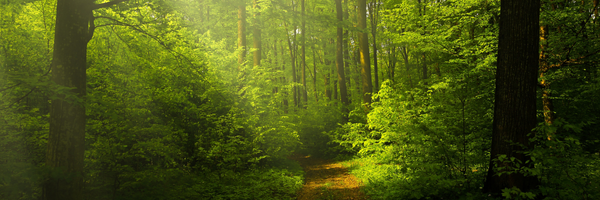
The Challenge
Acedia (uh-SEE-dee-uh) is an old term with new relevance. Once used by early monks to describe a sense of restlessness, boredom, and loss of purpose, it’s regrettably familiar to what many people feel in a screen-saturated world—especially in the age of social media.
On average, we spend more than half of our day staring at screens—a mix of work obligations and personal scrolling. These activities don’t satisfy our deeper needs for connection, purpose, or personal progress. Instead, they often leave us feeling disengaged from our work, from each other, and ourselves.
Our modern environments (including enclosed offices, artificial light, long hours of screen time, and sedentary lifestyles) are misaligned with how we thrive. This mismatch affects everything from circadian rhythms to stress response, mood, energy, and sleep, ultimately taking a toll on our health and well-being. Burnout is on the rise, energy is low, and mental health challenges are a leading driver of lost productivity. Depression and anxiety are costing the global economy an estimated $1 trillion annually and 12 billion working days.
Solutions to refresh, refocus, and reconnect are critical to successful personalized nutrition and health programs— people want more holistic lifestyle inputs. Stress and fatigue are priorities for personalized nutrition consumers. Our research further underscores the importance of quality sleep, effective stress management, and increased energy among key needs.
The Green Solution
What’s the antidote to this digital drain? It could be as simple as stepping outside for "green time."
Spend time in parks, forests, and other natural environments. Unlike endless scrolling, nature provides a sense of perspective, movement, light exposure, and even social connection. It reminds us that we’re part of something larger, pulling us out of self-focused loops and into the present.
Here’s what makes green time particularly powerful for personalized wellness: individual responses vary dramatically based on personality, lifestyle, and environment. Urban dwellers may need different doses of nature than rural residents. Introverts might benefit from solitary forest walks, while extroverts thrive in group outdoor activities. Just a few minutes outside—walking, looking up at the sky, or even tending to a plant—can create a meaningful shift tailored to individual needs and preferences.
Research suggests that green time may boost mood, energy, and productivity, while reducing stress. It’s one of the most accessible strategies for supporting wellness daily—and one that can be personalized based on stress biomarkers, sleep data, or mood tracking patterns.
Evidence Behind Green Time
- Structured nature-based interventions work. A systematic review analyzing 50 studies found that nature-based programs significantly improved mood, reduced anxious feelings, and enhanced positive feelings—especially when delivered over 8–12 weeks in 20–90 minute sessions. This effect appears linked to reduced neural activity in the prefrontal cortex of the brain.
- Forest “bathing” delivers measurable benefits. A systematic review of 26 studies confirmed that forest exposure is associated with beneficial effects on stress, well-being, and symptoms of anxiety and depression.
- Green spaces supersede urban environments. Compared to built environments, walking in nature led to greater reductions in fatigue and anxiety—and boosted energy and mood—in a 2022 analysis of 24 experimental studies.
- Physical health benefits are substantial. Increased access to green spaces is associated with reduced risk of cardiovascular disease, type 2 diabetes risk, and all-cause mortality risk, as well as improved physiological stress markers like cortisol and blood pressure. Getting two hours or more of time in nature each week was linked to good self-reported health.
Consumer Wellness to Workplace Strategy
Time in nature isn’t just good for people—it’s good for business.
- For individuals: Green time supports core wellness goals, such as stress reduction, mood support, and increased energy—key benefits sought by personalized nutrition consumers.
- For brands: As consumers increasingly prioritize emotional wellness and holistic self-care, embedding nature-based messaging and tools into platforms, services, and digital health products creates new opportunities for differentiation.
- For employers: Time spent outdoors is linked to reduced burnout, better cognitive performance, and improved employee well-being, all of which support retention, productivity, and morale. Even small shifts, such as walking meetings, nature-based retreats, or built-in outdoor breaks, could make a measurable difference.
Green-Time Opportunities for Your Personalized Nutrition Business
- Make it personal: Integrate “nature breaks” into app notifications based on user stress patterns detected through wearables. Include nature time guidance in wellness apps offering recommendations tailored to location, weather, and individual preferences. Introduce “green prescriptions” based on individual biomarker patterns.
- Make it fun: Explore partnerships with parks or arboretums to encourage activity. Help users track outdoor minutes via app integration with personalized targets based on stress levels and sleep quality. Enable users to create communities to hold each other accountable and share success stories.
- Make it a way of working: Design “green breaks” into daily routines—both at home and work. Implement walking 1:1s for managers. Create outdoor meeting spaces or offer “green commute” incentives for employees who bike or walk to work.
"Green" Line
Nature is accessible, effective, and infinitely personalizable. In the quest to develop better wellness strategies and healthier workplaces, “green time” may be one of the most straightforward and scalable solutions we have. As biometric tracking advances, we’ll soon be able to prescribe optimal nature doses based on individual stress patterns, circadian rhythms, and genetic predispositions—making the great outdoors our most sophisticated personalized wellness tool.